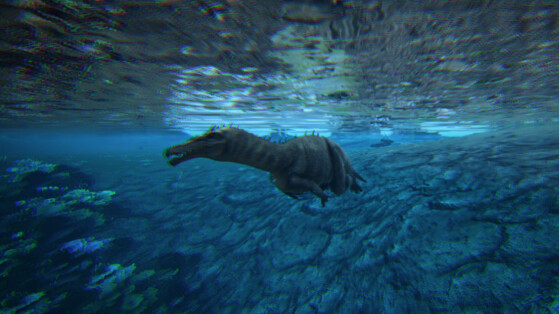In Ark: Survival Evolved, the Baryonyx is largely reminiscent of the famous and terrifying theropods that dot the island. However, it is recognized quite quickly by its head that resembles that of a huge crocodile and its rather frail body. Rather imposing and even terrifying, the Baryonyx is a loving dinosaur above the water depths, it is his element. Exclusively piscivorous, it feeds only on fish and is very weak once out of the water. In this guide we explain the most important things you need to know about this dinosaur.
Table of Contents
Where can you find Baryonyx in Ark?
Due to its fish-eating nature, the Baryonyx tends to lurk around areas of water. Generally quite rare, it is most often seen on the side of swampy areas and a little more rarely on the beaches. It is important to know that the Baryonyx is not only a good runner, but also an excellent swimmer, making him a rather difficult opponent to seed especially at low level.
However, even if it feeds only on fish Baryonyx is openly hostile to all creatures it sees, including the Survivor. It is therefore a real predator that should not be underestimated. However, it is particularly weak and not very resistant, so you will have no trouble conquering it on dry land. Under water, on the other hand, run away from him, he is clearly in his element there and will not give you respite.
Peculiarities of Baryonyx in Ark
- Aquatic Mountain: An excellent swimmer Baryonyx is a very good aquatic mount for new players. Able to compete with many predators much more imposing than him, in particular thanks to his tail flick (right click by default), this one doesn’t stun all creatures though, so watch out! However, we know that it is mainly the Spinosaurus and the Sarcosuchus. In addition, it is possible to use a weapon if you have one Baryonyxallowing you not only to fight more effectively, but also to harvest more easily Oil And Silica beads Underwater.
- Cave explorer: Thanks to its relatively small stature, the Baryonyx can be used as a mount in caves and other caverns, especially artifact cellars. Very handy, can jump but also run and swim quickly, it is a considerable asset.
- Regeneration: One of this dinosaur’s greatest strengths is its almost supernatural ability to regenerate. As long as he has Fish, meat in inventory, it regains hit points at a pretty impressive rate, so you know what to do to get one Baryonyx very, very strong!
Taming: how to tame the Baryonyx?
Taming Baryonyx is quite easy provided you can slow it down as it is quite fast and can get you in trouble if it overtakes you. The ideal is to throw it Bolas to immobilize him and then shoot him a few times Tranquilizer Arrows to put him to sleep for the effect of Bolas does not fade. If you aim at the head, it will deal more damage to it. Anesthesia and will put him to sleep faster.
Another technique is to pull it off Tranquilizer Arrows from the air thanks to a flying dinosaur, a Argentavis For example. Both work very well, it’s up to you!
In any case, plan a good supply of Narcotics and heightened surveillance: the Torpor of the Baryonyx drops quickly and he shouldn’t wake up because you haven’t been paying attention.
In terms of food, this creature is particularly fond of because of its fish-eating nature Ordinary kibble and from Meat of fish (baked on top Or top raw ideal).
How to breed Baryonyx?
The reproduction of Baryonyx requires the presence of a male and a female of this species in the same room.
Randomly and at a rate of about one egg every 18 to 48 hours, the female Baryonyx lies one Egg by Baryonyx. This can be eaten by the player or used for crafting Ordinary kibblebut to give birth to a small one Baryonyx you have to hatch the egg by placing it on the ground and provide it with acceptable conditions for the development of the young.
In case of Baryonyx, her egg hatched in about 1h59min after being incubated under the right conditions. It needs a temperature that fluctuates between 29 and 35°C to hatch, otherwise it will lose health. It is also interesting to know that the incubation time can be reduced by up to 20% if the egg is placed in an incubator set at the ideal temperature.



